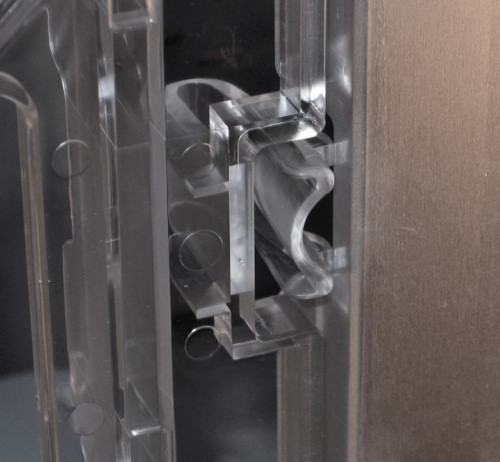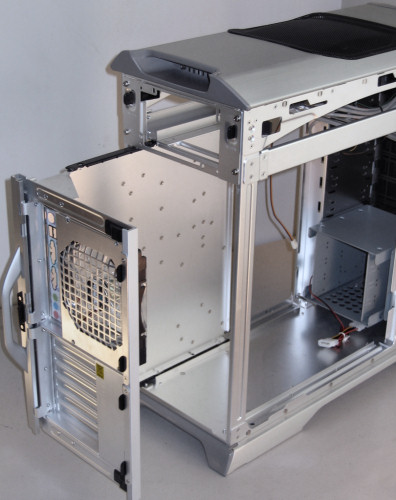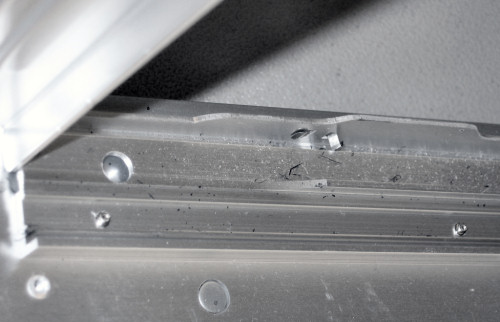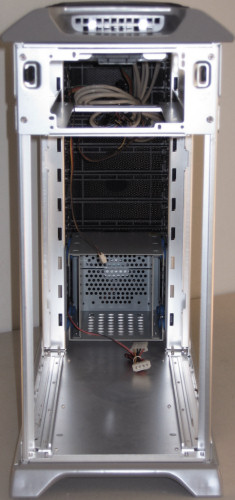Clash of the Titans - TT Tai Chi vs. CM Stacker 830
by Joshua Buss on February 23, 2006 12:05 AM EST- Posted in
- Cases/Cooling/PSUs
Cooler Master Stacker 830 (cont’d)
Cooler Master made the side fan cage's implementation nearly perfect, which really makes it one of the nicest aspects of the entire case.
Two clips, just like the one pictured above, hold the door shut at the front when it's in its hinges. They're simple, effective, and since they are built like small springs, they help to absorb any extra vibrations, which helps minimize noise.
At the back on the top and bottom, the door is suspended between two springs.
These spring-loaded stubs keep the door aligned perfectly for swinging, but release to make its entire removal easily possible. It really is a great feature and goes a long way to make the case a delight in which to work.
Along with the side panels and fan cage, the motherboard tray can be taken out as well, but unlike the Tai Chi, the Stacker's tray includes the rear and comes out the back. The black clips halfway down the left side and at the top and bottom on the right side in this picture are what lock the tray in place; once unlocked, the tray slides along plastic rails, which brings us to our next picture.
After only a few cycles of removing the tray and putting it back in, we noticed that plastic shavings were accumulating at the bottom of the case. While certainly it won't affect the case in any huge manner, it does mean that eventually the fit of the tray to the rest of the case might not be as snug as it is initially.
With the tray out, the 830 is amazingly open. In this shot from the rear, we can barely see the third and final included 120mm fan at the front of the hard drive cage. Also take note that there is almost perfect symmetry to the new Stacker – even the rails for the motherboard tray are on both sides. More on that to come.
Cooler Master made the side fan cage's implementation nearly perfect, which really makes it one of the nicest aspects of the entire case.
Two clips, just like the one pictured above, hold the door shut at the front when it's in its hinges. They're simple, effective, and since they are built like small springs, they help to absorb any extra vibrations, which helps minimize noise.
At the back on the top and bottom, the door is suspended between two springs.
These spring-loaded stubs keep the door aligned perfectly for swinging, but release to make its entire removal easily possible. It really is a great feature and goes a long way to make the case a delight in which to work.
Along with the side panels and fan cage, the motherboard tray can be taken out as well, but unlike the Tai Chi, the Stacker's tray includes the rear and comes out the back. The black clips halfway down the left side and at the top and bottom on the right side in this picture are what lock the tray in place; once unlocked, the tray slides along plastic rails, which brings us to our next picture.
After only a few cycles of removing the tray and putting it back in, we noticed that plastic shavings were accumulating at the bottom of the case. While certainly it won't affect the case in any huge manner, it does mean that eventually the fit of the tray to the rest of the case might not be as snug as it is initially.
With the tray out, the 830 is amazingly open. In this shot from the rear, we can barely see the third and final included 120mm fan at the front of the hard drive cage. Also take note that there is almost perfect symmetry to the new Stacker – even the rails for the motherboard tray are on both sides. More on that to come.















55 Comments
View All Comments
JoshuaBuss - Thursday, February 23, 2006 - link
What about direct links to images? Does that work?http://images.anandtech.com/reviews/cases/roundups...">http://images.anandtech.com/reviews/cases/roundups...
Jojo7 - Thursday, February 23, 2006 - link
No.JoshuaBuss - Thursday, February 23, 2006 - link
Try a refresh. Sometimes the image server gets a bit bogged down.latino666 - Thursday, February 23, 2006 - link
Still can't get crap. I notice this problem also with the newegg article too. Man oh man did I want to see those pics.ATWindsor - Thursday, February 23, 2006 - link
The tai-chi has gigantic heat-sinks on the side, but to me they seem like little more then a gimmick. Almost nothing is in physical contact with them, and when they are only taking heat fom air, they seem to be virtually useless. I bet the diffrences if one had a "standard" side would be hardly measurable.The CM 830 surly is more ugly than the old model IMHO, It doesn't quit have that "large clean beast"-feeling anymore.
Cygni - Thursday, February 23, 2006 - link
It seems they were going for the look of the Zalman completly fanless case, but didnt bother to install the flush mount PSU or heatpipes that ran into the doors, haha. :p Oh well.Tamale - Thursday, February 23, 2006 - link
I'd call it a 'large techno beast' now ;)Howard - Thursday, February 23, 2006 - link
The 3/8" holes in the Tai Chi can easily be bored out with a twist drill bit (the regular ones) in a cordless drill. At least, they would be if the material is aluminum, and I think it is.JoshuaBuss - Thursday, February 23, 2006 - link
Yah, but it's still much easier when it can be taken apart and pieces can be worked on individually.Googer - Thursday, February 23, 2006 - link
Could you invert the motherboard on the CM Stacker by installing the tray on the left side in place of the usual right side? If you could possibly allow for better CPU cooling sine the processor would be sitting on the bottome getting plenty of cool air and allowing hot exhaust to escape upwards.